The legendary 1911 pistol is one of those things that creates urban myth, conjecture, and misconceptions among the firearms community. For many people, the 1911 pattern pistol is simply a wonderful gun that is fun to collect, great to shoot, excels in competition and has endless possibilities in terms of modifications and personalization. All of this is great, and I have guns that fall into all of the above categories. If you are a person interested in any of the aforementioned uses, the information in this article may not be what you are looking for. What we will be looking at here is the 1911 in true service use. That means everyday carry, high round counts, and continual training (shooting at least weekly). It is a gun that you are literally trusting with your life as well as the lives of others.
Full-size, 5-inch, all steel 1911 service pistols are not the guns most people choose in this self-defense role. They are big, heavy, and require constant user attention. If you are not willing to make a substantial lifestyle investment, this is not the gun for you. Like a lot of people, I am very well served by a soulless, polymer-framed service pistol. With that said, I have gone through numerous 1911 phases in life, and like an old friend, I always come back to them with renewed enthusiasm. They bring a sense of confidence, and I will tell anyone that the 1911 .45 ACP pistol is the finest close-quarters gunfighting pistol ever made. However, since most people aren’t doing a lot of close-quarters gunfighting, and because of the other demands of the 1911 on the user, you might not think this is the gun for you. Despite its intricacies, the 1911 has a lot of redeeming qualities, and it would behoove any gun enthusiast to know a little something about them regardless of one’s intent to ever own or carry one. So, if you are still interested, and with that disclaimer out of the way, let’s take a look at three areas of note regarding the 1911 as a service pistol.
What The 1911 Needs
This part is critical. This applies to every single pistol you are staking your life on. You need a 100% reliable, manufacturer-supported, serviceable pistol. There are many of these out there but in the case of the 1911, I have found that the choices are limited. Personally, my hard use service 1911s are almost exclusively Colts, simply because they meet the needed criteria of having factory-trained armorers available for police officers, factory-certified gunsmiths, and a high level of factory support.
As a police officer involved in firearms training and in the firearms industry since college, I have handled tens of thousands of law enforcement service guns. None of them are immune to issues. Just because a company uses state of the art production techniques does not mean that a bad gun (or a bad batch of guns) can’t slip through from time to time. I have seen issue-pistols with unfinished parts, problems with some phase of the cycle of operation (usually extraction and ejection), magazines that are unreliable, and guns that would simply not go “bang” right out of the box. The best thing you can do with any service pistol, and particularly the 1911, is to have an experienced and well-trained armorer go through the gun prior to putting it into service.
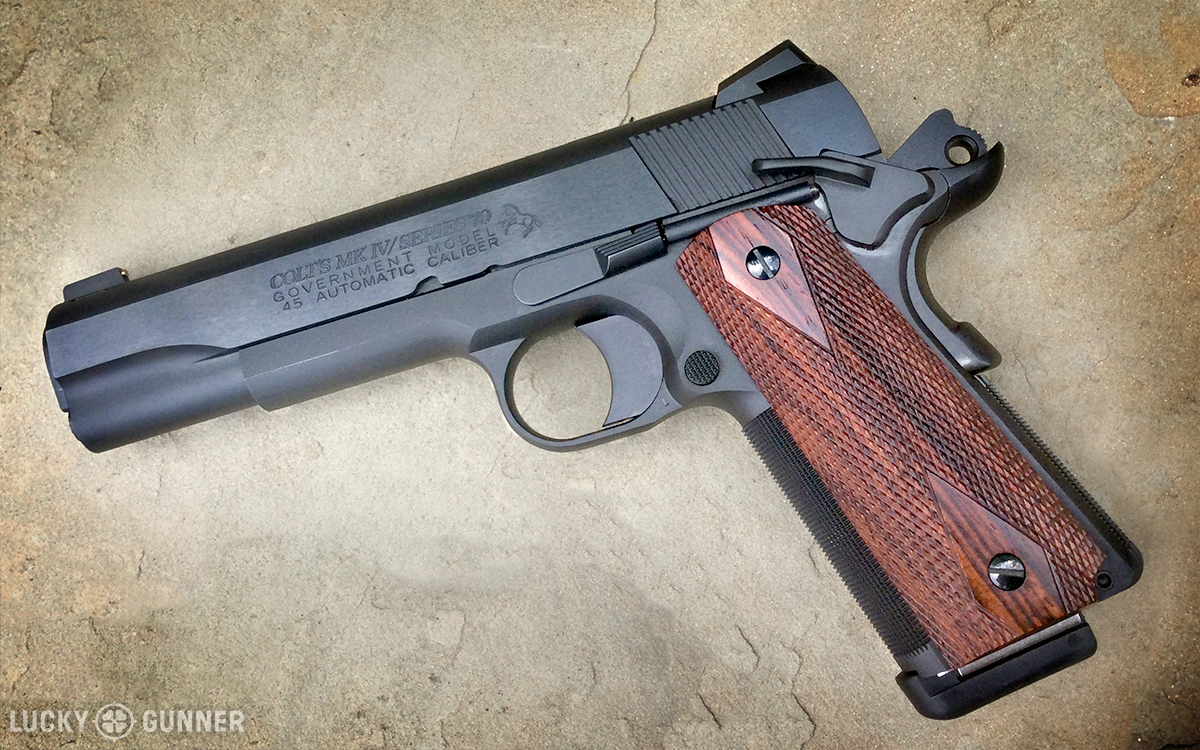
A simple cleaning up of some of the internals is a good investment with most of the current popular modern service pistols. In the case of the 1911, things are a little more complicated. At minimum, a good $100 reliability package is a solid insurance policy from an established gunsmith or a good factory-trained armorer. Keep in mind that there is not a single true “drop-in part” in a 1911. While most armorer courses use a simple set of punches for required tools, the 1911 needs files. This is not a job for a hobby smith. It requires someone who knows their stuff and has the right tools. I recently had some time on a $4,000 high performance 1911 from a well-established firearms company. The gun was a work of art, shot well, and seemed to be reliable in a simple range test. However, when subjected to a more detailed examination and inspection by a skilled armorer, that pistol failed numerous function tests and protocols. Making sure your gun passes all function checks, ensuring all the parts are well fit, and determining that the gun is set up to run the performance ammunition you’ve chosen is critical, especially since the springs that work with your training ammunition may be way too light for some of the current +P performance loadings.
Another “need” is to ensure your magazines all work reliably with your pistol. Over a long history with 1911 pistols, this is an area that has given me fits. I have had guns that simply “didn’t like” certain brands of magazines that worked flawlessly in other guns. I have seen more malfunctions and issues with 1911 pistols as a result of either bad magazines or magazines that don’t work with a particular gun. Unlike most of the newer service pistols, there are hundreds of magazine variants out there for the 1911, and they are not created equal or built to any sort of standard. When your magazines start having problems, trash them. They are disposable. Do not buy used magazines as they are often somebody else’s problems. Currently, most of my hard-use pistols are being run with Chip McCormick magazines that I test and rotate every six months. Do not be afraid to change to something else if you see that there is a reliability or longevity issue with what you are using. Just because it works in a friend’s gun or some super secret military unit uses them does not mean it will work in your gun. So, in short, if you decide to take on a 1911 as your primary everyday pistol, you need to have a professional ensure that it is properly set up and runs flawlessly with all of the magazines and ammunition you will use.
Basic Modifications: What the 1911 “Should Have”
One of the benefits to the 1911 is that a cottage industry has grown to the point that you can modify your gun in more ways than you can imagine. Some of these modifications are for improved ergonomics or based on personal taste, such as using the type of sights that work best for you. If the stock sights that come with your gun suffice, great. Sights are a personal choice and vary widely from person to person. The best sights for a person can also change with age, vision issues, experience or how the gun is being used. You should have a set of sights on your gun that allow you to efficiently pick them up quickly with your vision and use them in all lighting conditions. I like the sight picture of an all black “u-notched” rear with some type of front sight that has a small circular indicator. This would be something like a 10-8 Performance rear and a front sight with a tritium cylinder, brass or gold bead, or a fiber optic tube. It is what I see well, and it took me years to figure out. It has also changed with both experience and age.
One of my best friends has had to go from using conventional sights to XS Big Dot Express sights on his high-end 1911. I was shocked when I saw this setup as it is fast but hard to work at distance. His exact words sum it up well, “I can’t hit shotgun hulls at 50 yards anymore, but I still outshoot all the kids.” He said that conventional sights are simply a blur and the XS sights are all he can see. The reality here is simple. Good sights, in combination with the exceptional fit of the 1911 to most shooters hands, and a trigger that is easy to press correctly under stress allow the 1911 to end fights quickly.
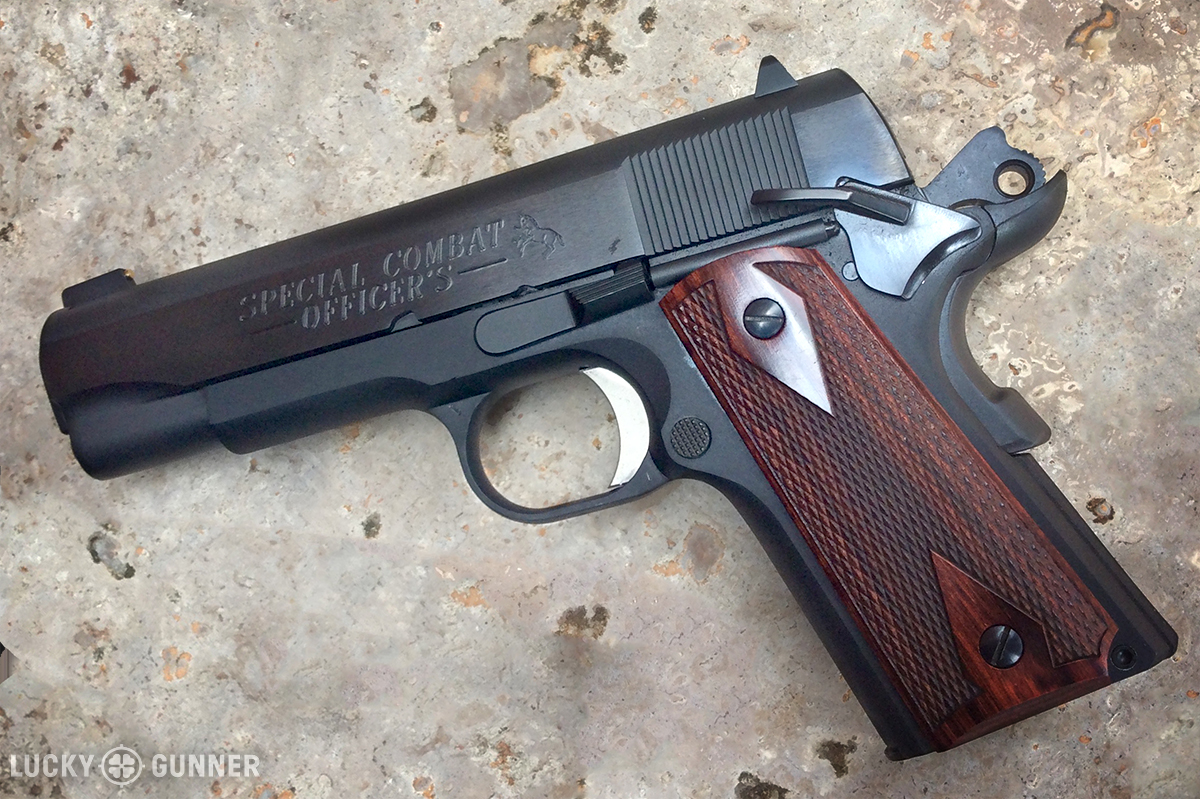
The next area is the safety. Use of the mechanical safety is critical for efficient operation of a 1911 as a service pistol. We all have very individual sized hands and grips. Installation of a frame safety (often in conjunction with a properly fit grip safety) is a good modification so that the use of that safety is seamless and happens at a nearly subconscious level. Those who are left handed will need an ambidextrous unit. These are a compromise, and I am not a big fan of them from a reliability standpoint for a right handed shooter. I have had a “medium” sized conventional unit from MARS Armament installed on most of my current hard-use 1911’s. Remember, everything on a 1911 must be properly fit, and these parts are not “drop-ins.”
You may also need to change or modify your grips to work with the type of safety that you have chosen. Grips should be efficient for the task at hand and allow for easy operation and manipulation of all the pistols controls. Conditions of use will dictate the texture of the grips. Select what works on a hard-use pistol, not what looks good. Save the ivories for your collector pieces and show-off pistols.
Lastly, the trigger. Again, we all have different size hands and fingers. I like tailoring the triggers on my 1911’s so I can get my index finger set up for an efficient straight press to the rear. My favorite of the aftermarket triggers is a flat 10-8 trigger. Prior to these, I always liked a “long trigger” combined with a flat mainspring housing. If what came on the gun is a good fit, leave it. If not, it makes sense to modify it to try and get that critical link between the finger and the trigger as optimal as possible.
At this point, if we have a very mechanically reliable pistol with its controls optimized for the individual who is carrying it, we are “there” on a solid duty/daily carry hard-use 1911. It should be noted that some companies like Colt and Springfield Armory have upgraded guns that are a few hundred dollars more than their base models with all the “should have” stuff on them. This can be big savings over buying a base model and having a well-qualified gunsmith do the work for you.
What We Want
Once you have met the needs and “should haves” of your 1911, you can now move on to the wants of your service-ready 1911. None of the following items are actually real needs but, but they are the things I have found really make the 1911 so special and a true extension of my hand.Getting a solid grip on the pistol in all conditions is imperative to efficient shooting performance. I like texturing both to the front of the grip frame and the rear
Getting a solid grip on the pistol in all conditions is imperative to efficient shooting performance. I like texturing both to the front of the grip frame and the rear mainspring housing to allow for solid front and rear pressure to be applied. I have found over the years that this is a very personal thing. Often, old school checkering was hard on my hands when in multi-day training courses. I started using golf ball texturing done by Steve Morrison at MARS Armaments in 2005. This was ideal for me, and now I can use grip panels that are appropriately textured for the pistol’s use as needed (sharper for use with gloves, smoother for concealment). I have severe arthritis in my hands and have lost a lot of grip strength over the years. Having a pistol with a grip that fits my hand perfectly and is textured in a way to help me control it is a good investment for me.
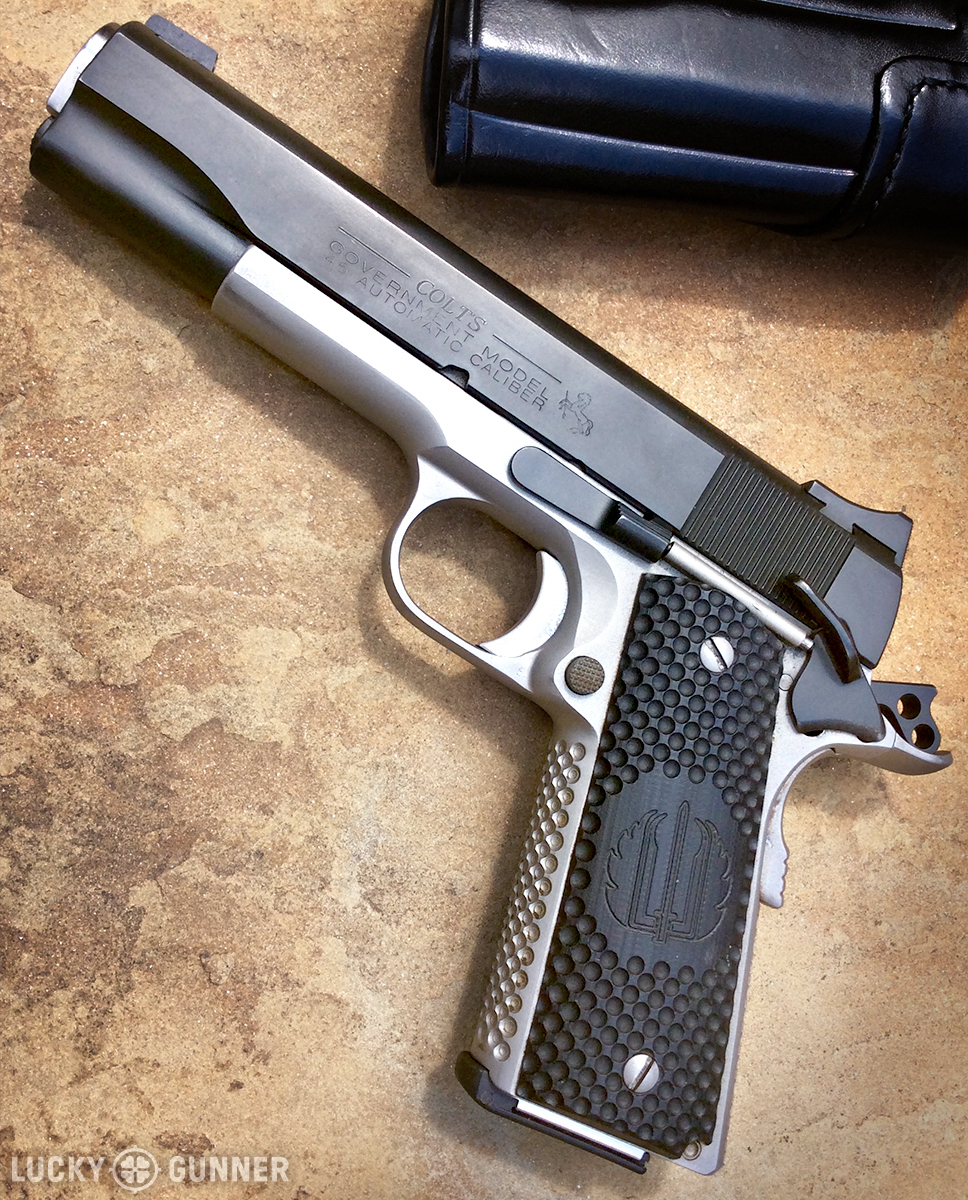
Another area in “things we want” is the ability to have the pistol coated in a finish that helps with maintenance. I have guns that run the gamut from blueing to Parkerizing. Some are stainless steel. The finish of our pistol will often dictate the level of maintenance needed. The 1911 is a gun that requires end users to stay on top of springs and lubrication. Anything we can do to lessen the load is a good thing. I have had great luck with Robar NP3 in the past. It allows the guns to function better due to its lubricity, and it is very corrosion resistant. The ability to clean the gun with a simple rag is also a nice bonus. Recently, I ventured into my first Cerakoted gun. While it has some good practical corrosion resistance properties over standard factory finishes, the reality is that being able to personalize the color scheme of your pistol is really just a pride of ownership benefit. My newest pistol actually had the Surefire X300 light that is Cerakoted in “Sniper Grey” to match the frame, while the slide and small parts are black. The two-tone look is a reflection of me having been in my prime in the 1980’s. Colored guns are far from the “need” and “should have” modifications, but it does give you some personal attachment to your pistol. Pride in your tools is simply a mindset thing. Having a pistol that has been personalized makes it feel “perfect” in my hand and because it looks the way I want it to look, I find myself handling the gun more and dry practicing more. All that dry practice is a critical part of any serious training program, and the more, the better.
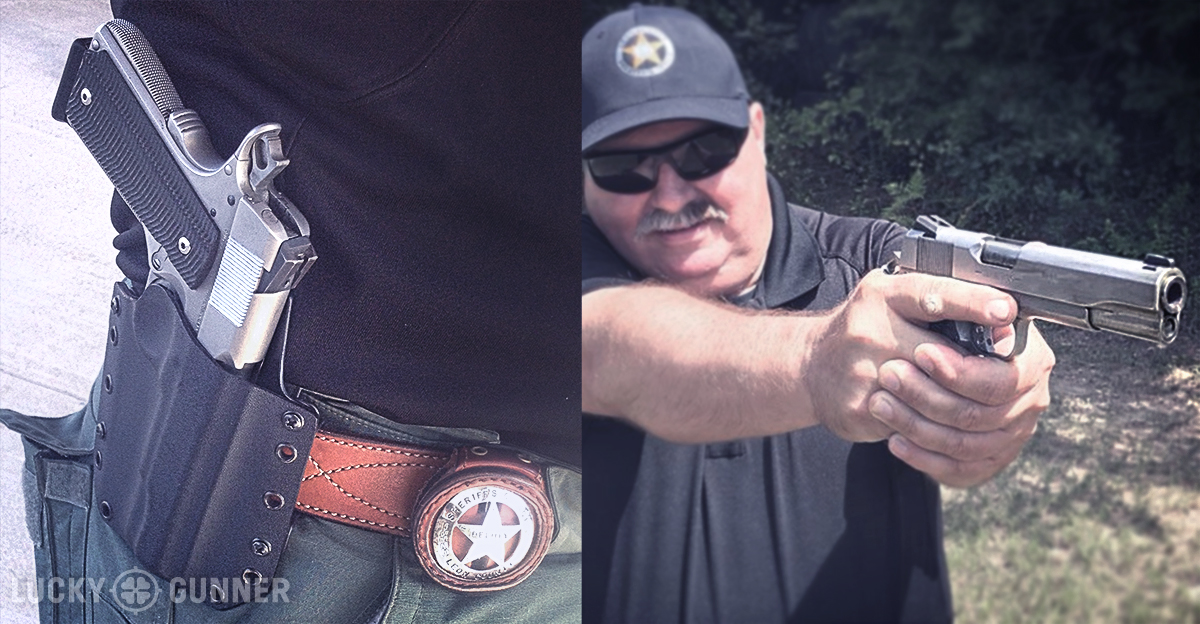
In the early 90’s, my first fully “bespoke” pistol was built for me by TJ’s Custom Gunworks. It was a pure concealment gun. A Lightweight Commander that was given the bar of soap feel by having all the sharp corners rounded and the frame was coated in the fairly slick Robar NP3 finish. To counter the slickness of the frame, a simple rough stippling was done to the front of the grip frame. This worked perfectly for its intended function. Again, fit the modifications to what you are using the pistol for and not mirroring what somebody else is doing. The modifications done to a pistol for use by a military unit tasked with overseas specialized combat operations will likely have different needs and requirements than a metropolitan police officer, an executive/VIP protective agent, an undercover narcotics officer, or a non-uniformed citizen carrying a concealed weapon daily. We don’t really have to do these types of “want” modifications, but it is these well-considered mods that can make that 1911 something very special and not just another gun we carry.
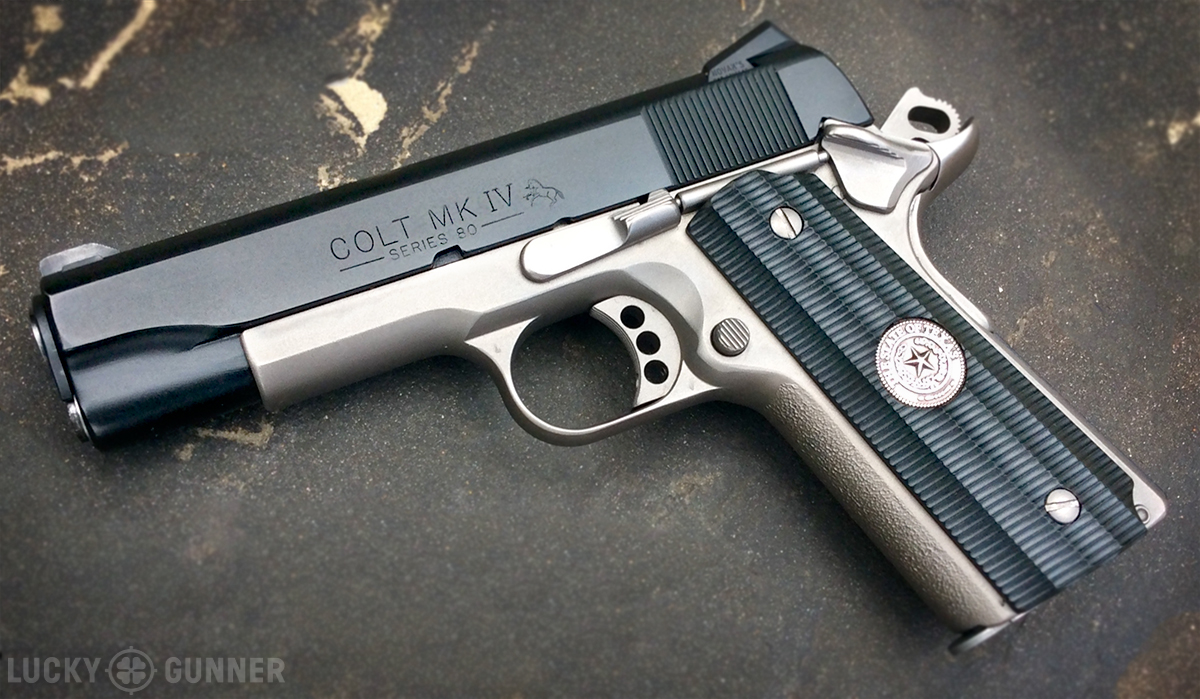
Overall, the 1911 pistol is one of my favorite things. The first guns I ever bought were a customized Series 70 Government Model and a Remington 870 shotgun. As I look back, those are still two of my favorite working tools. Even after having a ton of time on more modern polymer-framed service pistols, I still flat love the 1911 and experience phases of going back to the finest close-quarters gunfighting pistol ever invented. When I do carry a 1911, it is set up with all of the modifications discussed in this article. The result has been noted by one of the range guys at my old agency when I show up to shoot on range days in my retirement: “How come your 1911s are the only ones I see that run flawlessly?”
My response sums it up. “They all say Colt on the side, and have a couple grand in them from real gunsmiths.”
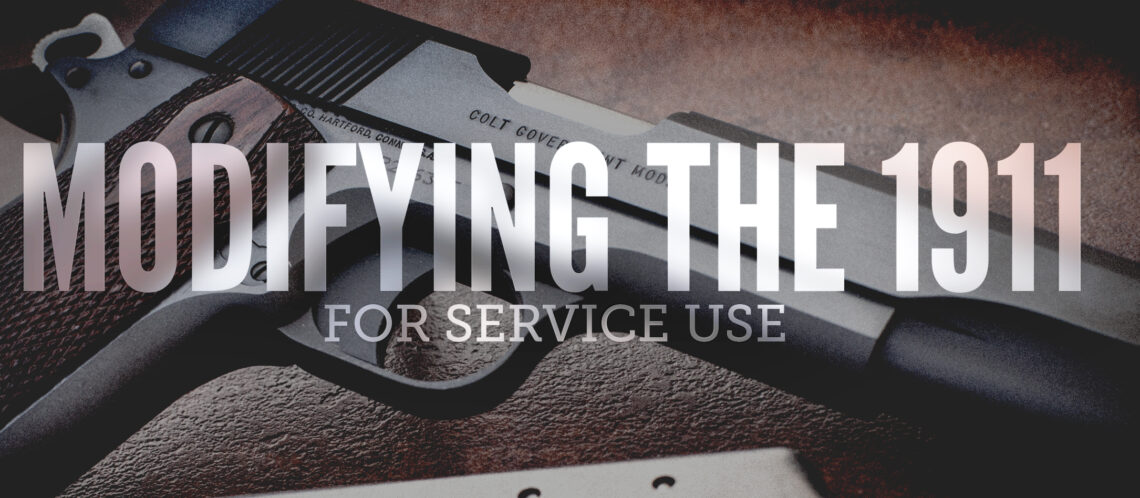

I started life with two Colt 1911’s, but transitioned to Glock’s in the 90’s and never looked back — WHY — the 1911 is expensive, it takes more diligence to keep running as a service weapon, they have more parts and issues than your basic Glock (magazines, as mentioned, can be a real problem). plus I like the mag capacity and weight of a Glock 17/19 for a service pistol. If I were to buy a new 1911 today I would buy a Springfield Armory… 🙂
Great article by someone who knows who he is talking about.
My biggest issues with 1911’s are the mags and the grip safety. Tape can take care of the latter (as can pinning if it is your own pistol).
You mentioned (but sorta glossed over) one of the main problems with the 1911 today: If you buy a 1911, you’re buying a pattern, not a proprietary product. By this I mean, for example, if you buy a Glock, it was made by Glock. If you buy a Sig, it was made by Sig, etc., and those companies will stand behind their products. But if you buy a “1911,” you could be buying a gem, or you could be buying a “parts gun” whose components weren’t all made on the same continent. So, caveat emptor.
Lik “sully v,” I carried Colt 1911s on duty, and I liked them. This was in the late 70s, before better autopistols were available. When my agency authorized Glocks and Sigs, it didn’t take me long to dump the 1911. Tradition is fine for toys, but not for lifesaving tools.
Another great article by Mr. B! Thank you!
All a Colt full size government model needs for “service” is a few full magazines, a holster, and a competent user.
Oh and may be a few bad guys who need ventilating.
True for today’s Colts. Forty years ago? Not so much. Colt’s quality has vastly improved and they are making excellent pistols today.
In addition, I wonder about whether current Colts can take the beating of high-round count training without further modification? Right now, I’d try a H&K, Glock, Beretta or SIG for that before even a Colt 1911 for the reasons stated in the article. Great pistol–but not really designed for high round count days, I suspect.
Yes true for Colts 40 years ago, 50 years ago, 100 years ago.
Wonder what ever you want. I have nothing against your list of foriegn, plastic upstarts but “Try” is the key word. I don’t “wonder” I carry a Colt and I carry it every day. I shoot it every day. No need to wonder. I KNOW.
Well, I handled some new Colts in the 1970’s that choked every other magazine. Others, of course, ran great, but the build quality was highly uneven back then. The USGI Colts (and Remingtons and Ithacas) ran well when properly maintained but weren’t all that accurate and of course were often not properly maintained. In addition, many had slides that would crack before 10,000 rounds.
I don’t doubt, however, that you have an excellent Colt. How many rounds do you have through it?
“How many rounds…” LOL, I remember when gun writers started that blather. I don’t even count the BUCKETS let alone “how many rounds”.
I can’t talk about gun writers, Jack, because I don’t read gun magazines.
However, I find that keeping round counts allows me to know ahead of time when springs need changing, though I have no criticism for someone who does things differently.
Why don’t you just buy a Swiss made quality product like the SIG (not Sig Sauer, only SIG) P210? Or the equally robust but not match grade shooting P220? I’ve used them a lot during my service time as a MP officer, never had a single hiccup with them. But maybe 9mm Para just isn’t enough for a. 45 obsessed US American…
Well, I wouldn’t say that I am .45 obsessed. I think that with modern hollow points the 9 mm is almost as effective as a .45 with hollow points, and that its somewhat-reduce recoil allows faster follow up shots. So, I generally use a 9mm–but that is dependent on the legality of hollow points.
However, in my army days I was often issued a .45, and I found them–when properly maintained–to be admirable weapon, and with FMJ ammo I’d rather have a .45 than a 9mm. Neither a round nose FMJ .45, nor a somewhat pointy round nose FMJ 9mm is designed for maximum terminal effects, but the .45 will generally do better simply because it is bigger and its shape is slightly more effective.
Thus, if I were unfortunate enough to live in the People’s Republics of New Jersey or San Francisco, where the carry of hollow points is banned, and I were somehow fortunate enough to be allowed to carry (and not being a celebrity or politician the chance of that in either place would be roughly zero), I might well opt for a .45 (or perhaps a hard-cast .357 wadcutter).
As for SIGs, the 210 is an amazingly accurate pistol, but the 220’s I have seen are usually in .45. Generally, I’d rather have a 226, 228 or 239 (the latter for concealed carry) than a 220, however.
Thanks for replying. I didn’t know that some states forbid you to carry specific types of ammunition, but then again I don’t live in the USA (altough deformative ammunition is also forbidden in Switzerland, except for the (military) police forces). So depending on which state one lives in, a FMJ .45 makes more sense than another caliber in the same configuration.
I have never shot, or seen a SIG bigger than a 9mm, because that’s just the standard ammunition we get to use in the army. So I can’t really talk much about the other caliber SIG (and Sauers for that case), as we have our homemade P210 and P220 with the magazine release at the bottom of the grips. The only good thing about that, is that you’ll never lose a magazine and it’s just more robust as there are less parts that could break.
The SIG Sauer 226, 228 and 239 all come in 9mm. They are all derivations of the 220, though the 226 and 228 have magazines carrying 13-18 rounds.
The bottom magazine release on the 210 and 220 make sense if you are unlikely to need to reload rapidly–which is true the vast majority of the time.
I think there have been very few gunfights in which a pistol holding 15 rounds needed to be reloaded during the fight, but I suppose there probably have been some.
I notice that Switzerland has replaced the 210 with the generation 4 Glock 17, which while not as accurate is also a pretty good pistol.
Finally, my view is that hollow point ammunition should be required for civilian defensive use. Not only is it more effective but it is much less likely to penetrate the bad guy and hit a little girl down the street. My view is that governments that are horrified by hollow points because of the Hague Convention in fact don’t understand what they are legislating about and are requiring the use of ammunition that is more–not less–dangerous to others.
I have always been a 1911 fan. I’ve been a cop for many years and never had the opportunity to carry one on duty. I’m a firearms instructor and armorer. We’ve always had Glocks. Ive learned to like them. But I still favor a Colt 1911. If I could I would carry my Special Combat Carry Model(1970CY). It runs flawless and is amazingly accurate.
The down side to carrying 1911 is they do require a more training for the average non-gun cop.
I know I’ll never see it(duty carry 1911) but it’s always an interesting debate when I suggest it!!
I like 1911’s and I have carried them. However, their biggest downside to me these days is their weight. More back pain is not something I need! (If I were still in my twenties (or even within a few decades of them) I might have a different opinion.
This year, I bought my first 1911 .45 cal. 5″ pistol. I tried all the famous–old standard manufacturers, Colt, S&W, Remington, Ruger, Ithaca, all upper end expensive base models $1200 – $2000. I liked many of them, especially the Colts, Remington and S&W. Then I got my hands on Springfield’s most expensive TRP model.
.
Once I tried it out, handled it, closed my eyes and held it out, opened my eyes and looked down the sight line and fired it. I felt the gun take possession of me. I knew right then, it did not matter what it cost, I was going home with it, no matter what. For the past 8 months my polymer pistols have been completely abandoned, except for my favorite pocket pistol, 45 cal. Springfield XDS 3.3″
.
I have a variety of McCormick magazines I’ve added to it, which all work flawlessly. Added the Dawson Tool less Guide Rod for ease of maintenance. Currently deciding on which light and or laser system to add to it, if I do. The Trijicon night sights are perfect for me and came stock.. The G10 aggressive grips seem natural for my needs.
.
Not sure what my next gun will be, but I am leaning toward a $2000 plus 1911 or having one built from the ground up, probably by Colt, Springfield or S&W. I’ll have to see which one ‘moves me’ into a lifelong relationship.
Why would anyone in this age of nearly flawless functioning weaponry, settle for a model that requires professional work right from the start, constant maintenance to maintain reliability & added cost for both maintenance and quality magazines??…If you just love everything 1911 and want one for target practice, or are a CHL that seldom carries, well then OK…but if you want a platform to protect you and your loved-ones, under the most extreme conditions, a platform that you can bet your life on every day…that is everything the 1911 is not, right out of the box…then buy a Glock…learn it, love it, shoot it.
I do love the 1911’s. I shot NRA service competition back in the 60’s for 3 paid for years in the USAF. I still shoot one. However, most know that if you get into a real life situation that that $2000+ super slick will spend several. if not many, years in a box in the evidence locker. I’d rather let the authorities fondle my Glock 19 while I continue to use my 1911 at the range. Anyone agree with the tradeoff? Besides, the Glock will eat anything in any mag you throw at it. Oh yes, I carried a GI Singer 1911 in Vietnam. It served me well.
am back again with the best stuff https://uploads.disquscdn.com/images/dc8e58b4f5b7ac2efed7728192acd115a7acbd3cca2ef7da1d8db66f3b83fbf7.png hey looking for guns i sell in dark market contact me all you need to do
is download wickr on apps store and contact me via lucho47
I have one 1911, an Argentine Systema that I’ve owned for 49 years. Over those years I’ve shot, literally, thousands of rounds through it. Like, maybe 10,000 rounds. Most of them have been 230 grain round nosed FMJ’s, but there have also been plenty of premium loads through it as well. It’s dead stock, never seen a gunsmith, always kept clean and loaded. I use about 6 or 7 magazines of different manufacturers. Throughout all this time and all those rounds, it has never once failed to function correctly or failed to fire. I guess I’m just truly blessed or terribly boring.